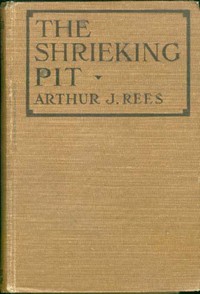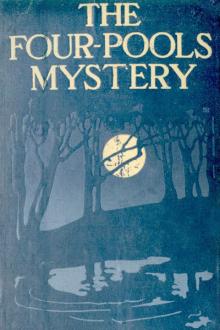The Shrieking Pit, Arthur J. Rees [reader novel .TXT] 📗

- Author: Arthur J. Rees
Book online «The Shrieking Pit, Arthur J. Rees [reader novel .TXT] 📗». Author Arthur J. Rees
"I am not so sure of that," said Colwyn. "But what do you make of this?"
He pointed to an impression in the red earth underneath Mr. Glenthorpe's window—a line so faint as to be barely noticeable, running outward from the wall for about eighteen inches, with another line about the same length running at right angles from it. Superintendent Galloway examined these two lines closely and then shook his head as though to intimate he could make nothing of them.
"What do you think they are?" said Mr. Cromering, turning to Colwyn.
"I think they may have been made by a box," was the reply.
"You are not suggesting that the murderer threw a box out of the window?" exclaimed Superintendent Galloway, staring at the detective. "Look how straight the line from the wall is! A box would have fallen crookedly."
"I do not suggest anything of the kind. If it was a box, it is more likely it was placed outside the window."
"For what purpose?"
"To help the murderer climb into the room."
"He didn't need it," replied Galloway. "It's an easy matter to get through this window from the ground. I can do it myself." He placed his hands on the sill,[Pg 64] sprang on to the window ledge, and dropped back again. "I attach no importance to these lines. They are so faint that they might have been made months ago. There is nothing to be seen here, so we may as well go and look at the footprints. Show us where the marks of the footsteps commence, Queensmead."
The constable led the way to the other side of the house and across the green. The grass terminated a little distance from the inn in a clay bank bordering a wide tract of bare and sterile land, which extended almost to the summit of the rise. Clearly defined in the clay and the black soft earth were two sets of footprints, one going towards the rise, and the other returning. The outgoing footsteps were deeply and distinctly outlined from heel to toe. The right foot plainly showed the circular mark of a rubber heel, which was missing in the other, though a sharp indentation showed the mark of the spike to which the rubber had been fastened.
"The footprints lead straight to the mouth of the pit where the body was thrown," said Queensmead.
"What a clue!" exclaimed Superintendent Galloway, his eyes sparkling with excitement. "You are quite certain the inn servant can swear that these marks were made by Ronald's boots, Queensmead?"
"There's no doubt on that point, sir," replied the constable. "She had the boots in her hands this morning, just before Ronald put them on, and she distinctly noticed that there was a rubber heel on the right boot, but not on the other."
"It seems a strange thing for a young man of Ronald's position to have rubber heels affixed to his boots," remarked Mr. Cromering. "I was under the impression that they were an economical device of the working[Pg 65] classes. But perhaps he found them useful to save his feet from jarring."
"We shall find them useful to hang him," responded Galloway curtly. "Let us proceed to the pit, gentlemen. May I ask you to keep clear of the footprints? I do not want them obliterated before I can take plaster casts."
They followed the footsteps up the rise. Near the summit they disappeared in a growth of nettles, but reappeared on the other side, skirting a number of bowl-shaped depressions clustered in groups along the brow of the rise. These were the hut circles—the pit dwellings of the early Britons, shallow excavations from six to eight feet deep, all running into one another, and choked with a rank growth of weeds. Between them and a little wood which covered the rest of the summit was an open space, with a hole gaping nakedly in the bare earth.
"That's the pit where the body was thrown," said Queensmead, walking to the brink.
The pit descended straight as a mining shaft until the sides disappeared in the interior gloom. It was impossible to guess at its depth because of the tangled creepers which lined its sides and obscured the view, but Mr. Cromering, speaking from his extensive knowledge of Norfolk geology, said it was fully thirty feet deep. He added that there was considerable difference of opinion among antiquaries to account for its greater depth. Some believed the pit was simply a larger specimen of the adjoining hut circles, running into a natural underground passage which had previously existed. But the more generally accepted theory was that the hut circles marked the site of a prehistoric village, and the deeper pit had been the quarry from which the Neolithic men had obtained the flints of which they made their imple[Pg 66]ments. These flints were imbedded in the chalk a long way from the surface, and to obtain them the cave men burrowed deeply into the clay, and then excavated horizontal galleries into the chalk. Several of the red-deer antler picks which they used for the purpose had been discovered when the pit was first explored twenty-five years ago.
"Mr. Glenthorpe was very much interested in the prehistoric and late Stone Age remains which are to be found in abundance along the Norfolk coast," he added. "He has enriched the national museums with a valuable collection of prehistoric man's implements and utensils, which he recovered in various parts of Norfolk. For some time past he had been carrying out explorations in this district in order to add to the collection. It is sad to think that he met his death while thus employed, and that his murdered body was thrown in the very pit which was, as it were, the centre of his explorations and the object of his keenest scientific curiosity."
"Did you ever see clearer footprints?" exclaimed the more practical-minded Galloway. "Look how deep they are near the edge of the pit, where the murderer braced himself to throw the body off his back into the hole. See! there is a spot of blood on the edge."
It was as he had said. The footprints were clear and distinct to the brink of the pit, but fainter as they turned away, showing that the man who had carried the body had stepped more lightly and easily after relieving himself of his terrible burden.
"I must take plaster casts of those prints before it rains," said Galloway. "They are far too valuable a piece of evidence to be lost. They form the final link in the case against Ronald."[Pg 67]
"You regard the case as conclusive, then?" said Colwyn.
"Of course I do. It is now a simple matter to reconstruct the crime from beginning to end. Ronald got through Mr. Glenthorpe's window last night in the dark. As the catch has not been forced, he either found it unlocked or opened it with a knife. After getting into the room he walked towards the foot of the bed. He listened to make sure that Mr. Glenthorpe was asleep, and then struck the match I picked up near the foot of the bed, lit the candle he was carrying, put it on the table beside the bed, and stabbed the sleeping man. Having secured the money, he unlocked the door, carried the corpse out on his shoulder, closed the door behind him but did not lock it, then took the body downstairs, let himself out of the back door, carried it up here and cast it into the pit. That's how the murder was committed."
"I agree with you that the murderer entered through the window," said Colwyn. "But why did he do so? It strikes me as important to clear that up. If Ronald is the murderer, why did he take the trouble to enter the room from the outside when he slept in the next room?"
"Surely you have not forgotten that the door was locked from inside? Benson says Mr. Glenthorpe was in the habit of locking his door and sleeping with the key under the pillow. Ronald no doubt first tried to enter the room by the door, but, finding it locked, climbed out of his window, and got into the room through the other window. He dared not break open the door for fear of disturbing the inmate or alarming the house."
"Then how do you account for the key being found in the outside of Mr. Glenthorpe's door this morning?"
"Quite easily. During the struggle or in the victim's death convulsions the bed-clothes were disarranged, and[Pg 68] Ronald saw the key beneath the pillow. Or he may have searched for it, as he knew he would need it before he could open the door and remove the body. It was easy for him to climb through the window to commit the murder, but he couldn't remove the body that way. After finding the key he unlocked the door, and put the key in the outside, intending to lock the door and remove the key as he left the room, so as to defer the discovery that Mr. Glenthorpe was missing until as long after his own departure in the morning as possible. He may have found it a difficult matter to stoop and lock the door and withdraw the key while he was encumbered with the corpse, so left it in the door till he returned from the pit. When he returned he was so exhausted with carrying the body several hundred yards, mostly uphill, that he forgot all about the key. That





Comments (0)